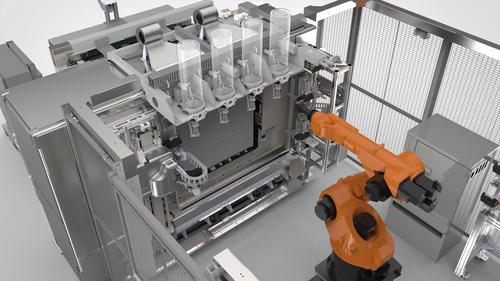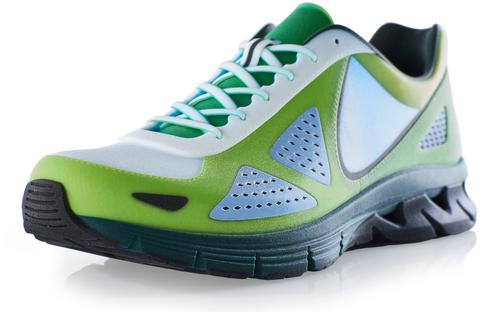Stratasys will be exhibiting two groundbreaking large-scale additive manufacturing technologies, as well as other new products, next month at the International Manufacturing Technology Show (IMTS) in Chicago.
August 29, 2016
Stratasys will be exhibiting two groundbreaking large-scale additive manufacturing technologies next month at the International Manufacturing Technology Show (IMTS) in Chicago, Sept. 12–17. These new technologies, developed in response to automotive and aerospace industry needs, were unveiled in the form of technology demonstrators at a global media summit held last week at company headquarters in Eden Prairie, Minn.

Stratasys' new fully automated Infinite Build 3D Demonstrator workcell includes in-situ process control for precise, repeatable mechanical properties and 10x the build speed of typical FDM machines. Along with the Robotic Composite 3D Demonstrator, it will be on display at the upcoming IMTS show in Chicago. Both breakthrough technology demonstrators were developed in response to industry needs, to bring accurate, repeatable manufacturing of very large thermoplastic end products, and much bigger composite parts, onto the factory floor.
Both the Infinite Build 3D Demonstrator and the Robotic Composite 3D Demonstrator are designed to bring accurate, repeatable manufacturing of very large thermoplastic end products, and much bigger composite parts, onto the factory floor. At the show, they will be featured in technology demonstrations at the company's booth. Although there are no formal product descriptions yet, or timelines for commercialization, for either demonstrator, the company is displaying them at IMTS 2016 to get feedback and input from the market, said Rich Garrity, president of Stratasys Americas, during the media summit.
 3D Printing's Brave New World. Ann Thryft will lead a panel discussion on one of the hottest topics in manufacturing: 3D printing. Come hear "3D Printing: The Brave New World of Manufacturing" at the Embedded Systems Conference, Sept. 21-22, 2016 in Minneapolis. Register here for the event, hosted by Design News’ parent company, UBM.
3D Printing's Brave New World. Ann Thryft will lead a panel discussion on one of the hottest topics in manufacturing: 3D printing. Come hear "3D Printing: The Brave New World of Manufacturing" at the Embedded Systems Conference, Sept. 21-22, 2016 in Minneapolis. Register here for the event, hosted by Design News’ parent company, UBM.
In addition to the Infinite Build and Robotic Composite 3D Demonstrators, Stratasys said it will also be showcasing several examples of applications produced with its 3D-printing technologies. These include parts made for several different types of tooling and manufacturing processes, including end-production parts, composite tooling, mold tooling, and jigs & fixtures.
At the media summit, several different examples of tooling, jigs, and fixtures were on display during the plant tour. One was a sacrificial tool used to make a hollow inlet duct, a technique often used for fabricating complex, hollow composite parts in the automotive, aerospace, and sporting goods industries.

This sacrificial tool, made with Stratasys' new ST-130 material that withstands autoclave heat, was used to create these composite hollow inlet ducts by Swift Engineering. The tool was fabricated using the company's new ST-130 material and new fill patterns, a solution now available for the Fortus 450mc and 900mc FDM 3D printers.
In this process, 3D-printed molds are wrapped in composite material and removed after the part cures, speeding the process and making it more cost-effective. The inlet duct sacrificial tool was fabricated using the company's new ST-130 material and new fill patterns. The solution is now available for the Fortus 450mc and 900mc FDM (fused deposition modeling) 3D printers.
READ MORE 3D PRINTING ARTICLES ON DESIGN NEWS:
A recent addition to the company's product line for making tooling, molds, jigs, and fixtures, as well as prototypes, is its J750. The latest addition to Stratasys' line of Objet Connex multicolor, multimaterial series of 3D PolyJet printers, this one has a six-material capacity, making it possible to mix and match full-color gradients plus a much wider range of materials.

This prototype of a sports shoe was made in a single print on the Stratasys J750 3D printer. With full-color, smooth surfaces, and a rubber-like sole, it matches the final product.
Engineers can choose from more than 360,000 different color shades for the J750, plus multiple material properties, ranging from rigid to flexible and from opaque to transparent. New PolyJet Studio streamlines workflow by letting users choose their materials, optimize the build, and manage print queues, via a simplified user interface. The printer also cuts in half the time needed to print simulated production plastics, like Digital ABS, compared to other PolyJet systems, due to its newly designed print heads.
[images via Stratasys]
Ann R. Thryft is senior technical editor, materials & assembly, for Design News. She's been writing about manufacturing- and electronics-related technologies for 29 years, covering manufacturing materials & processes, alternative energy, and robotics. In the past, she's also written about machine vision and all kinds of communications.
About the Author(s)
You May Also Like



